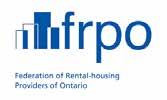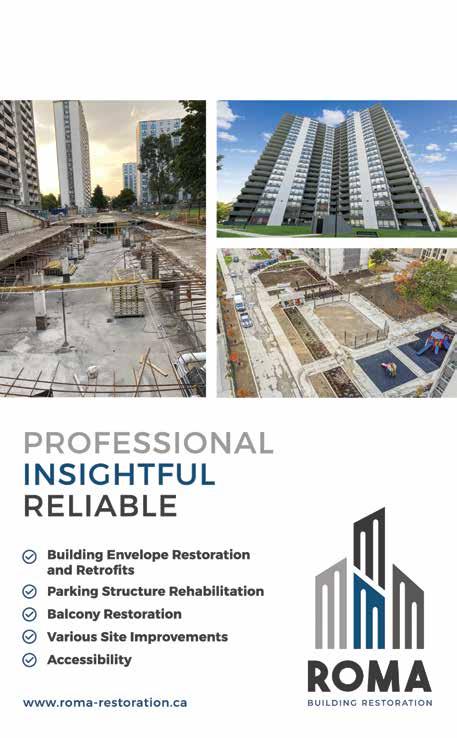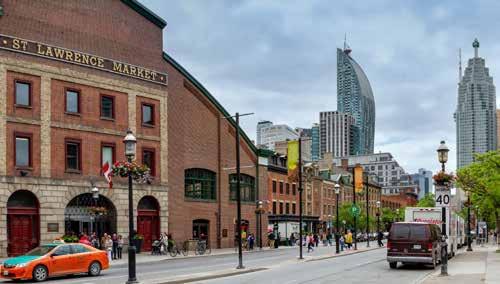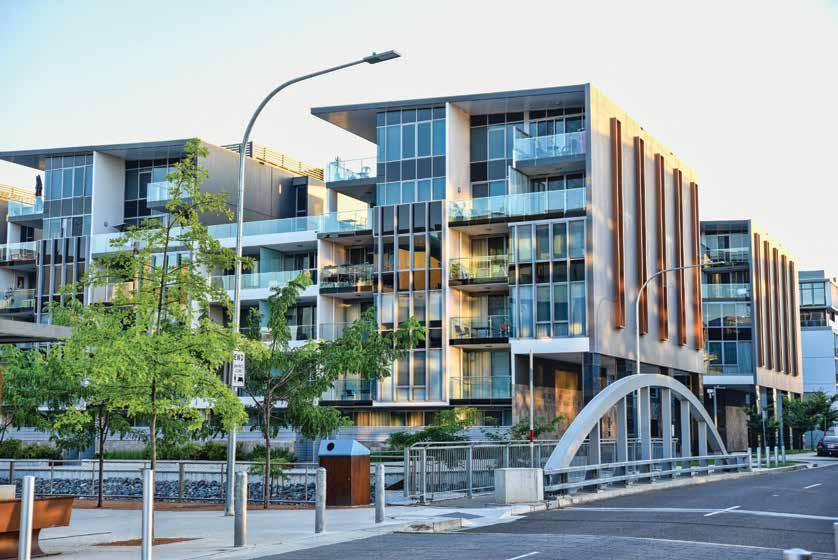








As a sister company to ACE Painting, Cranfield General Contracting was formed in 2004 to further meet the remodeling demands of all our clients. Delivering superior quality and cutting edge solutions Cranfield provides major renovation services to include interior, exterior, in suite and common area upgrades.
UPGRADES | ELECTRICAL PLUMBING | MILLWORK

/cammediaedge /cdnapartmentmag /mediaedgecam
How to best tackle Canada’s affordable housing crisis has been a contentious debate for years. But today, it’s a topic you just can’t escape.
As Toronto prepares to head to the poles and vote in its next mayor, housing is a loaded subject central to election campaigns. From pressing the federal government to waive HST on all new large-scale, purpose-built rental projects, to strengthening eviction prevention programs and stopping “shady renovictions,” right or wrong, each candidate has been vocal about addressing housing in his or her own way. By the time this issue is in full circulation, the city’s new mayor will be putting their money where their mouth was, so to speak. You can read all about each contender’s housing platform on our website, www.REMInetwork.com.
In the meantime, we hope you enjoy our “Who’s Who” issue featuring this year’s ranking of top players in the rental housing space. We also look at the benefits of heat pump retrofits, plans for a proposed new mixed- use development in Scarborough, and perspectives on inclusive housing and the financialization of housing in Canada. As usual, we also provide a timely snapshot of what’s happening in the rental market today. For those of you wishing to share your own perspectives or analysis, or if you have any thoughts on future articles, please reach out to me at erinr@mediaedge.ca.
Wishing you all the best as we head into summer!
Sincerely,
Erin Ruddy @cdnapartmentmagEditor Erin Ruddy
Art Director Annette Carlucci

Graphic Designer Thuy Huynh
Production Coordinator Ines Louis
Contributing Writers Andy Schwartze, Chris Seepe
National Sales Bryan Chong Melissa Valentini
Digital Media Director Steven Chester
Circulation Adrian Holland
For sales information call (416) 512-8186
Canadian Apartment Magazine is published six times a year by:
2001 Sheppard Avenue East, Suite 500 | Toronto, Ontario M2J 4Z8 E-mail: info@mediaedge.ca
President Kevin Brown
Group Publisher Sean Foley
Copyright 2023
Canada Post Canadian Publications Mail Sales Product Agreement No. 40063056 ISSN 1712-140X
Circulation 416-512-8186 ext. 234 circulation@mediaedge.ca
Subscription Rates: Canada: 1 year, $50*, 2 years, $90*, US $75
International $100, Single Copy Sales: Canada: $12*
* Plus applicable taxes
Requests for permission to reprint any portion of this magazine should be sent to Erin Ruddy.
Authors: Canadian Apartment Magazine accepts unsolicited query letters and article suggestions.
Manufacturers: Those wishing to have their products reviewed should contact the publisher or send information to the attention of the editor. The opinions expressed are those of the authors of articles and do not necessarily reflect the views of Canadian Apartment Magazine. This information is general and is not a substitute for legal advice.
Sworn Statement of Circulation: Available from the publisher upon written request. Although Canadian Apartment Magazine makes every effort to ensure the accuracy of the information published, we cannot be held liable for any errors or omissions, however caused. Printed in Canada.










16 HEAT PUMPS ARE A WINNING INVESTMENT

Why now’s the time to make the switch by Erin Ruddy
20 TORONTO’S LEGACY OF INCLUSIVE CITYBUILDING
Are mixed-income developments the right approach during a housing crisis? by Erin Ruddy


26 WHO’S WHO 2023 Canada’s top-ranking apartment owners and managers ON














































The Canadian multi-suite residential rental market remained tight during the second quarter of 2023, with demand generally outdistancing the supply of available units. The high cost of owning a home in most regions of the country combined with record-high immigration supported strong demand patterns.
Given the limited supply, many landlords were able to command higher rents when units were vacated. At the same time, landlords were also able to push rents higher still for existing renters, in accordance with provincial guidelines where rent controls were in place. Newly built rental buildings were generally leased up quickly in most major markets across Canada.
“Rental market conditions have improved over the past several quarters and have more than made up for the pandemic-influenced downturn,” observed Keith Reading, Director of Research at Morguard.
Multi-suite residential rental properties continue to be a prime target



Source: Morguard

of various investment groups. That said, activity levels were relatively subdued due to the high interest rates during the second quarter. According to Reading, many buyers remain on the sidelines awaiting pricing stabilization.
“Investors continue to exhibit interest in acquiring stabilized properties, given the sector’s healthy long-term outlook and continued rent growth forecast,” he said, adding that very few large-scale portfolios were offered for sale during the second quarter. “To some extent this reduced the volume of investment capital placed in the Canadian multi-suite residential rental sector.”

Reading predicts that investment activity levels will remain muted over the near term, given the relatively high cost of debt capital and an uncertain economic backdrop.
Rents hit their lowest rates in April 2021, but have since risen 20 per cent according to Shaun Hildebrand, President of Urbanation.
“Rents continued to face upward pressure across Canada during April, 2023, with the strongest growth felt in markets that see the highest levels of immigration,” he said. “Tenants that signed leases during the pandemic may be facing rent increases of 20 per cent or more if they decide to move, causing reduced turnover that is exacerbating the low supply situation.”
Each of Canada’s six largest rental markets continued to see rents rise by more than 10 per cent over the past year. Compared to the pandemic low in 2021, rents for condominium and purpose-built apartments have increased the most in Vancouver (up 47 per cent) and in Toronto (up 41 per cent).
Twelve Ontario cities saw significant increases in asking rents with three GTA markets in particular exceeding 30 per cent in one year: Scarborough at 31.9 per cent, Brampton at 31.2 per cent and Markham at 30.3 per cent. All three markets have been affected by high levels of immigration. Oakville was the most expensive mediumsized market in Canada in April for condo rentals and apartments with average monthly rents at $3,413.



Consider the following:
• Who will represent your best interest?
• Who will give your property maximum exposure?
• Who will deliver the highest value for your property?
With over 30 years of experience, tens of thousands of units sold, and hundreds of clients represented, we have consistently delivered superior results. Through our local and national coverage, we create maximum exposure, ensuring maximum value for your property.
David Montressor
Vice Chairman Sales Representative (416) 815-2332
david.montressor@cbre.com
Tom Schuster Associate Director Sales Representative (416) 847-3257
tom.schuster@cbre.com
Research completed by the University of British Columbia using CMHC data shows that almost 80 per cent of housing starts between 2016 and 2021 in Canada’s largest cities were in low-amenity neighbourhoods. Fewer than 10 per cent were in high-amenity neighbourhoods.
Overall, Toronto had the highest level of starts in high-amenity census tracts at 21 per cent, while Calgary and Edmonton didn’t have any starts in highamenity areas.
In terms of apartment construction, multifamily units tend to be more optimally located, with 36 per cent built in medium- and high-amenity areas. New single-detached,
semi-detached and row units were located almost exclusively in low-amenity areas (95% to 98%).
The proportion of mid-rise apartment buildings (4 to 6 storeys and 7 to 20 storeys) increased in 2022 in the Toronto area. The proportion of apartment buildings with 21 or more storeys, meanwhile, decreased. Mid-rise buildings have shorter construction
times, and as a result, CMHC contends they could help increase the number of units on the market more quickly.
“With greater housing demand from a growing population, Canada’s cities need to deliver more housing units on limited and expensive developable land,” the Housing Supply Report states. “Apartments are increasingly being developed even in cities
Aside from apartments, most new construction was in low-amenity neighbourhoods
like Calgary and Edmonton, which have traditionally grown by expanding their urban periphery. This growing trend toward densification is an important tool for improving housing affordability and lowering the energy footprint of the housing stock.”


Low interest rates in the first quarter of 2022 contributed to home prices reaching record highs in many Canadian cities. As interest rates increased in 2022, homebuyer purchasing power dropped in the second half of the year. This was followed by a slight decrease in home prices in most markets. While the shift led some developers to take a more cautious approach to new condominium projects, low vacancy rates and rising rents sparked interest in purposebuilt rentals in every centre except Toronto, where condominiums remained dominant.
More apartments in Canada’s urban housing stock
Canada’s six largest centres experienced a major surge in apartment construction. In Toronto, Vancouver and Montréal, apartment construction made up over 70 per cent of total starts. Apartments made up most of the new construction in Montréal at nearly 87% — even though the total number of starts, apartments included, dropped in the CMA.


Metro Vancouver
• Despite industry challenges, residential construction remained high and stayed stable in 2022.
• While apartment starts remained almost unchanged, there was a significant drop in condominium apartment construction. This was offset by a surge in rental apartment starts.
• Starts in Coquitlam increased, keeping pace with transit-oriented development and growth in the municipality.
Edmonton
• New purpose-built rental apartment construction increased in 2022. Growth was driven by projects near the downtown core and in developing neighbourhoods outside the centre.
• Semi-detached starts were an exception to the growth and saw a 24% drop compared to 2021.
• Single-detached and townhome starts saw gains of 8.3% and 4.5% respectively.
Calgary
• Residential construction in Calgary hit a record high in 2022, surpassing the previous record in 2014.
• Townhome and apartment starts had the strongest gains as both segments saw a yearover-year increase of 23%.
“Canada’s six largest centres experienced a major surge in apartment construction.”
• Growth in the share of apartment starts accounted for 45% of total housing starts.
• Based on data going back to 1990, rental starts were at the highest level on record.
Toronto
• While housing construction activity in Toronto increased in 2022, the supply of newly completed homes available for purchase was at the second-lowest level on record.
• The Ontario construction labour strike in mid-2022, supply-chain delays and skilledtrade labour shortages disrupted building activity during the year.
• Purpose-built rental apartments were the only housing type that decreased in 2022 (down 7% from 2021). This was the second year in a row that rental apartment starts decreased.

• Condominiums continued to dominate construction, with an 86% share of apartment starts.

Ottawa




• T he increase in housing starts was due to increases in the rental apartment and condominium segments. Both types of apartments accounted for more than 50% of housing starts in 2022.
• Single-detached housing starts decreased by 22%, falling slightly below the previous 5-year average. Row house starts decreased by 9% but remained above average.
Montréal
• The decrease in housing starts in Montréal, varied by dwelling type. Freehold housing construction decreased by 38%, the greatest
decrease among all dwelling types and the lowest level ever recorded.

• Although rental apartment starts declined by 28% in 2022, they remained the most built type of housing structure last year.
For more info, download the Housing Supply Report at: cmhc-schl.gc.ca
Over the next 25 years, building owners and managers will become increasingly responsible for green initiatives as part of each property’s operational mandate. According to Natural Resources Canada and the Canada Green Building Strategy, each building will be called upon to reduce its carbon footprint so that by 2050, Canada will be as close to net-zero emissions as possible.
Working towards this, the Canadian Certified Rental Building ProgramTM (CRBP) requires each property to meet set standards toward Environmental Management, a facet which includes “working with residents to ‘green’ apartment communities and lower their environmental footprint.”
The CRBP was formed by the Federation of Rental-Housing Providers of Ontario (FRPO) in 2008 as a resident-focused apartment building certification program. Opening up the conversation with residents around green-living ideas, the CRBP introduced its Canada-wide ‘Conscious-Living’ Box Giveaway in 2020. The contest encourages participants to enter for a chance to win one of 100 eco-sustainable packages focused on helping reduce their carbon footprint.
The contest opens June 15 and runs until September 15, with draws throughout the summer. One hundred entrants will be randomly chosen to receive a curated box with purposeful and sustainable products. The ‘Conscious-Living’ Box Giveaway is open to all residents of apartments, condos, and homes across Canada. Entrants do not need to live in a CRB apartment building to take part.
Now in its third year, the Conscious-Living box highlights the CRB’s Living Green TogetherTM component, an integral step in the certification process for Canadian Certified Rental Buildings. In multiresidential properties, managers often hear from residents who want to be more productive regarding recycling and composting practices but feel they lack control in relation to building policies.

The Conscious-Living Box Giveaway campaign drives resident engagement at the community level as well as on social media. Two social media influencers, Flora Law (@thefloralaw) from BC, and Sarah Robertson-Barnes (@sarah.robertson.barnes) from Ontario, are championing the campaign.
The CRBP’s Environmental Management assessment focuses on energy consumption and water usage — with a requirement for building managers to act quickly if a leaky water source is reported — and ways to reduce garbage and increase recycling.
“All CRB-approved buildings are Living Green TogetherTM certified. In addition to the Program’s 55 standards-of-practice, are an additional 10 standards-of-practice that are ‘green’ and ‘eco-conscious’ focused,” explains Maria Arangio, Marketing and Creative Director at Creativo Advertising, who leads the Conscious-Living Box campaign for the CRBP.
“This national campaign aims to educate the public that everyone’s environmental efforts matter, especially in our multi-residential communities. For industry members that are actively engaged in environmental, social, and governance (ESG) and Global Real Estate Sustainability Benchmark (GRESB) reporting, the Canadian CRBP provides impactful support to these endeavours. As a GRESB-approved green building sustainability program, it provides members with quantifiable measures for incorporating ESG factors into daily operations and supports their efforts with residents, the community, and government stakeholders.”
As we count down to 2050, information regarding each property’s energy efficiency will become public knowledge — a move which could shake-up the real estate market and ensure the mindset of green living as a daily practice.

The CRBP encourages building managers to provide information about the Conscious-Living Box giveaway to their residents to grow their communities’ engagement and kick-start conversations around environmental impact.
Winners of the boxes receive products from 8 to 10 Canadian eco-focused businesses. The box also comes with a LookBook showcasing each product including a quick review of green initiatives undertaken in CRB properties Canada-wide, and further ideas for sustainable living.
The online entry form includes a short series of questions focused on their existing environmental practices. Additionally, winners will get the opportunity to win a $100 gift card if they post a photo or video reel opening their box to social media with the hashtag #LOVECRB.
Arangio explains when a property undergoes the steps to become a Canadian Certified Rental Building, it shows a level of transparency, awareness, and commitment to their residents and the industry. For potential renters, it provides a sense of comfort knowing that the building’s management and operations are considered to be well-run, well-managed and well-maintained.
“Having attended more than 50 resident BBQ events throughout the GTA and Ottawa on behalf of the CRBP, it was exciting to connect with residents and share awareness on how every effort matters. We can make a difference within our apartment communities through Living Green TogetherTM.”
Tony Irwin, President and CEO of FRPO explains, “The CRB Conscious-Living Giveaway is a powerful initiative that empowers property managers to take the lead in promoting Green Apartment Living among their residents. By sharing this giveaway in our communities, we can inspire a generation of conscious individuals to make small yet impactful changes in their daily lives. With the program expanding nationally, we aim to support our members and help educate residents that our individual efforts matter.”
Arangio said the 2022 campaign was a huge success and she expects 2023 to triple in entries. “Last year’s giveaway was a huge success with incredible participation, exposure and online engagement,” says Arangio. “With FRPO member support, I anticipate this year will be even more successful. A win-win for everyone!”
To make it easy for building owners and managers, the CRBP has created marketing materials which can be easily distributed to residents. The Conscious-Living Box giveaway kicks off on June 15th.
For more information, please visit crbprogram.org
Retrofitting with heat pumps is known to deliver tremendous benefits, including lowering energy costs, reducing demand on the grid, improving tenant comfort, and helping landlords on their path to attaining net-zero carbon targets. Still, some rental housing providers have been reluctant to jump on board, fearing the upfront cost and chaos typically associated with any major retrofit project.
But times are changing, and the reluctance is duly waning. Since 2019, REITs and large commercial landlords like QuadReal, CAPREIT, and DREAM Unlimited, have been turning to this cleantech solution and paving the way for smaller rental housing operators to follow. In June, for example, Dream enlisted BONDI Energy Corp to help it decarbonize one of
its aging multi-unit properties located at 723 Bloor Street West in Toronto, the ultimate goal being to transition to a 100 per cent Net Zero portfolio in the coming years.

“This project is significant because it’s one of the first fuel-switching projects of its kind in the region,” explained Belinda Gilbey, President and Co-founder of BONDI Energy, an award-winning cleantech project
developer based in Toronto. “The apartment building was constructed in 1915. It has no air conditioning provision and a hydronic hot water radiator system. Our team was brought on to help design and implement a new Variable Refrigerant Flow (VRFV) system, which will significantly reduce the property’s environmental impact and improve occupant comfort.”
The move from gas to electric will also eliminate the asset’s central gas plant cost and secure it against rising energy costs. To accommodate the new heat pumps, Toronto Hydro is increasing the building’s electrical capacity from the street, and the units are expected to be operational later this summer.
“Our net zero commitments are necessary evolutionary steps in our business and align with our impact investing focus, which has formed an integral part of who we are, how we invest, how we have done business for more than 25 years, and how we will grow in the future.,” said Pino DiMascio, Head of Impact Strategy and Delivery, Dream Unlimited Corp. “We are tackling the impact on GHG emissions between now and 2035 that are within our direct control, and by doing that we are creating flexibility to handle the more challenging emissions sources that require collaboration with partners, tenants and supply chains.”

Invented in the 1980s, heat pump technology is considered one of the most energyefficient ways to heat and cool buildings and


plays a vital role in the global shift toward decarbonization. Heat pumps draw heat into the building from the cold outdoor air in the winter and push the warm air out in the summer, providing a cost-efficient way to aircondition the living space and improve the tenant experience.
“From a landlord’s perspective, retrofitting with heat pumps really increases the value of the building from day one,” said Aaron Graben, Co-Founder and Vice President of
BONDI Energy Corp. “Heat pumps are three times more efficient than other heating and cooling systems, and they significantly lower energy expenses resulting in increased cap rate values.”


In fact, for every electrically heated apartment retrofitted with heat pumps, Graben said the asset value increases by about $25,000; additionally, they decrease the electrical capacity requirements by up to 60 per cent allowing owners to arbitrage the surplus capacity to allow for more EV charging stations and Utility Peak Demand programs.

For gas buildings, heat pump retrofits eliminate the central gas plant cost while securing the building against rising energy costs and fines. Meanwhile, tenants get a better, healthier occupancy experience, which translates into lower vacancies and potentially higher rents.
“Investors today want to see buildings move to a lower carbon efficiency to meet Net Zero and ESG goals,” Graben added. “Retrofitting with heat pumps is not a marginal move — its energy efficiency impact is massive compared to all other retrofits.”


Given the current, higher interest rates, many multifamily building owners may be inclined to defer major retrofit projects (particularly if the building is sub-metred) but Gilbey and Graben argue that the investment now will result in benefits that could dwindle the longer they are postponed.
“The business case is currently quite strong to retrofit existing apartments with heat pump technology,” said Gilbey. “Not only are the efficiency gains huge, but governments
are looking to multifamily and commercial building owners to lower GHG emissions to reach aggressive net-zero carbon objectives. Carbon taxes are already here, and incentives won’t last forever.”
To her point, qualifying building owners can take advantage of the CMHC MLI Select Program, attaining 100 points, which allows for 50-year amortization and other loan benefits. There are also numerous rebates and government incentives available,

including the new 30 per cent federal tax credits, to help make the switch to heat pumps more affordable. On larger portfolios, the Canadian Infrastructure Bank is providing extremely low financing that many institutional landlords are accessing, including Dream and Kingsette. And in terms of the disruption to tenants, working with professionals like Bondi Energy ensure it’s kept to a minimum with one-day turn turnaround times per unit.
“Heat pump retrofits have the potential to revolutionize the way we approach building energy consumption and reduce our carbon footprint,” concluded Graben. “With significant energy savings and a positive impact on the environment, it’s no wonder more and more building owners are opting for this technology. It’s the best way to offset rising electricity costs, interest rates, and inflationary operating costs.”
• Buildings are the largest source of GHG emissions in Toronto today, accounting for 58% of total emissions. The emissions stem from the burning of fossil fuels, primarily natural gas, for heating, cooling, and hot water. Switching from fossil fuels to heat pumps eliminates building emissions by 100%.
• If Ontario retrofitted all 400,000 electrically heated apartments, it would be equivalent to reducing the Pickering Nuclear Power plant’s annual generation by 12%.
• Heat pump retrofits are a great way to create green jobs while spurring new technologies and applications. Currently, over $1 Trillion dollars in building retrofits are expected to be executed over the next 50 to 100 years in North America.
• Governments are implementing carbon fines and taxes (like Law 97 in New York) that penalise building owners that fail to reduce carbon emissions.
• Heat pump technology can Increase a building’s cap rate value by $25,000 per suite. For example, on a 100-unit building, that’s a $2,500,000 increase in value (based on a 4% cap rate).
BONDI Energy Corp specializes in decarbonizing buildings with energyefficient, cost-saving heat pumps and deep energy retrofits, management, and ongoing maintenance. For more information visit www.bondicorp.com.















Are mixed-income developments the right approach during a housing crisis?
As the city of Toronto accelerates efforts to address housing affordability, inclusivity and the barriers inhibiting rapid housing development were top of mind at the Urban Land Institute’s Spring Meeting in mid-May.

Toronto urgently needs more housing, of all sizes and tenures. With flagship government initiatives like Housing Now failing to gain traction since it launched in 2019 — despite the City’s $1.3 billion commitment — any attempts to expedite the delivery of purpose-built rental housing have stalled. This failure to get shovels in the ground comes at a time when the need for more purpose-built rental housing has never been greater. Toronto’s vacancy rate currently sits at 1.7 per cent, and home ownership rates have dropped to the lowest level on record. Mean-while, there is increased pressure to expand rental housing supply to support the anticipated population and economic growth through unprecedented immigration.
Although the Housing Now program suffered largely from pandemic-driven challenges, including lockdowns, supply chain issues, labour shortages and rising construction costs, the fact re-mains Toronto has been short on housing for years.
“We have only recently begun to get some really good data that demonstrates the magnitude of the supply challenge,” said Jennifer Keesmaat of Markee Developments/The

Keesmaat Group and moderator of the session entitled, Housing Affordability: Success is in the Mix. “This data puts a fine point on what’s been happening over the course of the past five to ten years — that we have a complete mismatch between the amount of growth we are seeing and the amount of supply we are delivering across the city. Anyone who looks around and sees the cranes in the sky is shocked by this because there is so much being built. But the truth is we are growing at an astronomical rate, and we have not seen our housing stats increase substantially after 2016.”
According to Keesmaat, the current supply deficit and the myth that the market will just “take care of affordability” have led to interventions by the government to ensure lowerincome residents aren’t edged out of coveted neighbourhoods. But Frank Lewinberg, Partner Emeritus at Urban Strategies Inc., said a comparable conversation was happening back in the 1970s.
“It was a similar time,” he said. “We were talking about the fast-rising housing prices, the difficulty of young people with families getting
housing, and the fact that lower income people had no hope at all.”
Hence why the federal government decided to invest in projects like the St. Lawrence Neighbourhood, Canada’s first attempt to develop a deliberately mixed-use, mixed-income community. As an architect on the project, Lewinberg said the mix of market-priced housing with public, non-profit and co-op residences became a catalyst for the neighbourhood at large, which was supported by necessary services like schools, supermarkets, restaurants and retail shops.
Today, the St. Lawrence Neighbourhood serves as a model for similar mixed-income projects, including Regent Park, Alexandra Park, and Lawrence Heights. As these examples show, the pursuit of inclusivity by blurring the income lines of residents can be an effective strategy for strengthening the city’s communities. But as the massive surge in population growth fuels an unprecedented housing crisis in Toronto, is the mixed-income approach to city-building still the right way forward?
“We are welcoming 500,000 new Canadians on an annual basis, many of whom will be
settling here in the GTA,” said Brad Bradford, City Councillor representing Beaches and East York, and candidate in the current Toronto mayoral race. “[This] puts a tremendous amount of challenge before us with respect to housing, coupled with 30 per cent increased cost of construction, 40 per cent increased cost in financing, and the shortage of labour and trades. We are facing his-toric headwinds.”
In addition to these challenges, there are rough political waters to navigate. As Bradford put it, “planning is politics” and politicians are not always known for getting things right.
“Some politicians have literally made their careers on the backs of opposing housing,” he said, citing examples of projects that were sidelined for having too many storeys or other unfavourable design features. “How do we create a culture of change? How do we move away from saying ‘no’ to saying ‘yes’ to housing opportunities?”
Bradford, like his fellow panelists, believe the answer still lies in the cross-subsidy model, calling it the “key to unlocking housing.” While the approach alleviates some of the financial bur-den given the market units cross-subsidize the affordable ones, the long-term benefits for the residents can include poverty alleviation, improved housing quality and services, better location and amenities — all of which contribute to healthier economic conditions and help break down barriers.
But to be truly feasible, the panelists agreed that large, mixed-income projects require additional financing from governments; less prohibitive fees and red tape; and a more outcome- vs. process-focused approach. According to Heela Omarkhail, VP, Social Impact at the Daniels Corporation, they also need strong partnerships.
“The ability for a private company to part-

ner with government and bring our thinking, our experiences and really help shape the process, was critical,” she said, referring to the Regent Park redevelopment project that began in 2005. “We were able to leverage our networks, our relationships, and our capital to bring more to the table.”
Flexibility is also a key requirement. Since the five-phase, 25-year redevelopment began, the plan hasn’t been static. In fact, according to Omarkhail it’s been rezoned
twice, with a third rezoning currently underway. Each time it’s been to capitalize on emerging opportunities.

But regardless of the income mix, or the scale of the housing project, one thing is certain: more housing across the entire housing continuum is needed in Toronto, from shelter space to affordable housing to market purpose-built rentals.
The time to build is now, and ‘all hands on deck’ are required to make it happen.
“We have only recently begun to get some really good data that demonstrates the magnitude of the supply challenge.”
 By Erin Ruddy
By Erin Ruddy
The aging plaza at 3730 Kingston Road in south Scarborough, Ontario, is poised to become a vibrant, mixed-use community hub, pending approval from Toronto City Council. Located near the Guildwood and Eglinton GO stations at the edge of Scarborough Village, the neighbourhood is characterized by its mix of high-rise apartment buildings, strip malls, townhouses—and to the south, upscale family homes overlooking Lake Ontario.

It’s a busy intersection that many people pass by on a daily basis and home to some well-loved local businesses that serve the needs of the community,” said Mark Chemij, Director, Development at TAS. “Over time, the two-storey plaza and neighbouring church property have become rundown and underutilized.”
But all that is about to change if the visionaries at TAS and SvN Architects have their way. The proposal for the site includes a 20-storey tower with communityserving commercial uses on the ground floor; generous amenity spaces for residents including an expansive outdoor courtyard; landscaping improvements and beautification along Kingston Road; and ample purpose-built rental supply, with 10 per cent pegged for affordable.
“Given the location has historically been car-oriented, there are limited amenities for pedestrians around this site,” Chemij
said. “The existing building is set back from the street with surface parking along the frontage and there is no sidewalk along the Scarborough Golf Club Road. The proposed development will provide a new sidewalk connecting the sidewalk to the north of our property to Kingston Road and include adjacent retail space accessible by pedestrians walking by.”
Future residents will be delighted to know that all ground-floor units facing both Scarborough Golf Club Road and Kingston
Road will include terraces, allowing them to look out over the attractive landscape elements promised for both street frontages. According to Chemij, the exterior design includes planters and seating at the southeast corner of the site near the retail, a space intended as a gathering place for tenants and pedestrians alike.
For those relying on public transit, the building’s proximity to the Guildwood and Eglinton GO stations is a feature that can’t be beat, as is the proposed Eglinton East

“We envision this space to be an extension of residents’ indoor living spaces and want it to look and feel like an outdoor living room that can change and adapt to their needs and the seasons.”
LRT stop located directly next to the site. Targeting a wide demographic, including young professionals and families with small children, a plethora of conveniences will be on hand, making a car-free existence a viable option for tenants ready to ditch the vehicle.

Meanwhile, for those seeking a higher aesthetic and a vibrant, connected community to call home, Chemij says to look no further.
“Having a central amenity courtyard is a feature of purpose-built rental apartments you don’t see often in Toronto,” he said. “We envision this space to be an extension of residents’ indoor living spaces and want it to look and feel like an outdoor living room that can change and adapt to their needs and the seasons. The architecture also has a unique juxtaposition of materials and colours to differentiate between the inner and outer elements of the building. The courtyard creates a void in the massing and is flanked by lighter facades to brighten the space, while the remaining facades are treated with darker masonry to create this contrast.”
If all goes according to plan, construction on the development will begin in late 2025.
In April, TAS filed a ZBA re-submission and first SPA submission for the project after purchasing the site from the previous owner in 2022. At that time, a denser 14-storey building with 435 market rental units, 383 parking spaces, and 2,784 square feet of commercial space had been planned for the site—features TAS has chosen to scale back for the sake of efficiency and affordability.
“As we looked at the project through the lens of our impact framework, we saw an opportunity to create a more environmentally efficient building that would better serve the community’s needs, while also providing returns for our investors,” Chemij said. “This project will serve the community by creating a more vibrant public realm, more attractive, modern retail spaces, and new housing options for individuals and families, including those seeking affordable rental homes.”
The plans are currently being reviewed by Toronto City Council. We will update on the status of this project as more news becomes available at www.reminetwork.com.

385 The West Mall – Multi-generational living with a focus on wellness
When complete, this 653-unit project will feature a mix of purpose-built rentals, for-sale condominiums, and community-focused commercial space, all located on one suburban site in Etobicoke, Ontario. After TAS completed its research and engagement process, the group determined that the area was lacking health and social services, as well as senior’s housing. As such, TAS sought out not-for-profit and commercial partnerships to help address these gaps and ensure the future development functions as a community hub and inclusive residence.
The new 12-storey building will include 180 rental homes with a mix of 1, 2 and 3-bedroom units, and communityserving retail on the ground floor. The project aims to be accessible to a diversity of residents across age, income, family size and ability. Using strategies like geothermal heating and cooling, a green roof, low-carbon concrete and storm water recycling to lower the carbon emissions of the building, it will be the first ground-up development project to formally target net zero embodied carbon.
Located in the burgeoning Greater Golden Mile, the vacant site of a former retail strip plaza is positioned to become a purpose-built rental building with an affordable housing component and community-serving retail on the ground floor. The Eglinton East site is extremely well-connected, with access to the Kennedy Subway Station, Kennedy GO Station and the future Eglinton East LRT, scheduled to be completed later this year.

2022 is turning out to be a promising year for the Canadian economy and multifamily industry. Canada is experiencing a robust recovery from the pandemic, adding more than 200,000 jobs and dropping the unemployment rate to 5.3% in Q1. To help with the talent shortage, Canada is striving to accept more than 400,000 immigrants by the end of the year, creating a ripe opportunity for the multifamily market.
The Q1 2022 Yardi Canadian Multifamily report showed rent growth is abundant across London, Hamilton and Kitchener-CambridgeWaterloo, with each area experiencing a 10% increase on average. While affordable housing is still an issue, a shift toward multi-use properties comprising of residential, office, retail and hotelling hopes to alleviate concerns within the real estate market.
According to a 2021 tenant survey by Informa Canada, more than 50% of renters found their ideal units online, with internet listing services (ILSs) appearing prominently in searches. But to really stand out and attract quality renters, your real estate marketing strategy needs to extend beyond the ILS.
Today’s customers expect properties to have a user-friendly, attractive and interactive online presence. In the same survey, 50% of renters who visited a property’s website said the visit influenced their decision to rent.
Search engine optimization (SEO) and reputation management should be foundational elements for your brand. While inexpensive compared to ILS costs, both require consistency and expertise. Some prefer to use an agency rather than manage inhouse. Putting SEO best practices in place now will lead to longterm success, helping your communities outrank the competition in local searches.
It’s an optimal year to take leasing to the next level, especially if your business plans to grow. In the Informa Canada survey, more than half of these renters preferred to interact with the leasing
office via email, text or chat, with only a minority still preferring to call. With the right technology, it’s easy to stay on top of evolving renter expectations. Your leasing and customer relationship management solution should offer your staff the flexibility to connect to prospects and residents 24/7, 365 days a year — from anywhere and via multiple channels.
To stay competitive and support your leasing team, integrate an omnichannel chatbot into your property websites and resident portals. Make sure to select a bot powered by artificial intelligence (AI) that can truly help your guests. This ensures prospects have a frictionless experience when inquiring about building amenities, tour options and lease agreements. Al is also the key to centralizing leasing data, keeping customer information current and accurate, and accelerating unit turnovers.
Overall, guiding your prospects through a seamless search and leasing experience can establish trust for your business and create more conversions down the road.
This is a transitional year with a positive outlook for the residential market. The next wave of renters expect a cohesive leasing experience, and the technology to meet their expectations is readily available. Yardi has completely integrated solutions that can help you achieve success every step of the way, from customer acquisition to resident retention. See it all at: yardi.com/ multifamily.
For more information about Yardi, please call (888) 569-2734 or visit yardi.com


























Dream Unlimited Corp., Kilmer Group, and Tricon Residential Inc. have officially launched Maple House, the first phase of Canary Landing in downtown Toronto. The 12-acre community is comprised of 2,300 rental units – of which 30 per cent will be dedicated as affordable housing and 25 per cent will be barrier-free, creating a model for inclusive, mixed-income communities.
Canary Landing is located in Toronto’s Canary District community, an award-winning urban village adjacent to the Distillery District. Canary Landing includes eight mixed-use buildings spanning four city blocks along Cherry Street. In addition to significant market and affordable rental housing, Canary Landing will also include 30,000 square feet of retail and a future 5,000 square foot community space.
The project represents an innovative public-private partnership between the DKT Partnership, the Province of Ontario, the City of Toronto, the Government of Canada, and the Canada Mortgage and Housing Corporation (CMHC).
“We are grateful for the collaboration with our municipal, provincial, and federal partners as we work towards our shared vision for Canary Landing, which will target ambitious LEED Gold sustainability outcomes, and provide long-term market rental and affordable housing,” said Andrew Joyner, Managing Director at Tricon Residential on behalf of the DKT Partnership. “Maple House is the start of fulfilling our promise to create beautiful, sustainable, and affordable housing, and we look forward to seeing residents thrive in this vibrant new community very soon.”
Bringing much-needed affordable housing to the city, the development team is delivering 126 rental homes that will be filled in partnership with seven non-profit agencies, including WoodGreen Community Services, Artscape, COSTI, Wigwamen, Performing Arts Lodge, March of Dimes and Interval House. These affordable rental homes will be offered at 40 to 80 per cent below the average market rent. An additional 105 affordable rental homes will be available to the public through a soon-to-be-released open market call. All 231 of the affordable homes have been financially supported by the City of Toronto’s Open Door Program.
“We have all watched as Toronto’s affordable housing crisis has grown during the past several years,” said Anne Babcock, CEO of WoodGreen Community Services. “WoodGreen Community Services is thrilled to be working with other not-for-profit agencies and the DKT Partnership to deliver real and permanent housing solutions to a diverse range of Toronto residents. The Canary Landing initiative is a testament to what we can all do by working together for the common good.”
In terms of architecture, the design team, which includes Danish firm COBE and Canadian firms Alliance and CCxA, focused on creating a “design-forward” and environmentally responsible community that respects the local heritage. Maple House has already garnered several accolades, including the Canadian Architect Award of Excellence and the 2021 BILD Award for Best New Community.
“We are incredibly proud to be delivering this truly mixed-income community that is the first of its kind in Canada and a model for citybuilding,” Joyner said. “This type of housing will strengthen our city’s social fabric and meet the diverse needs of all Torontonians.”

The Government of Canada announced it is building a coast-tocoast network of electric vehicle (EV) charging stations along highways and in public places, including in multi- residential buildings and workplaces. Specifically, the funding will go towards the installation of over 1,800 new EV chargers at sites across the country, including Guelph.
“We’re making electric vehicles more affordable and charging more available where Canadians live, work and play,” said the Hon. Jonathan Wilkinson, Minister of Natural Resources. “Investing in more EV chargers, like the ones announced today in Guelph, will put more Canadians in the driver’s seat on the road to a strong, healthy net-zero future.”
Partnering organizations include:


• Skyline Real Estate Holdings Inc. for 852 Level 2 chargers in Ontario, Quebec, New Brunswick, Nova Scotia, Manitoba and British Columbia.

• The Corporation of the City of Guelph for 24 Level 2 and four Level 3 chargers across Guelph.

• Alectra Utilities Corporation and Alectra Energy Services Inc. for up to 905 Level 2 and 72 Level 3 EV chargers across Ontario.


The combined federal investment of more than $12 million provided through Natural Resources Canada’s Zero-Emission Vehicle Infrastructure Program is in addition to the funding provided by the organizations, bringing the total combined project costs to more than $27 million.
“Skyline is proud to be partnering with NRCan to make EV infrastructure more readily accessible to apartment tenants in our communities,” said Rob Stein, President, Skyline Energy. “Not only do the chargers present an added benefit for the building’s tenants — they will also make a meaningful positive impact on the development of Canada’s clean energy sector.”
Multifamily landlords in Toronto could qualify for grants of up to $1.5 million through a newly launched energy retrofit initiative for buildings of 3+ storeys constructed before 1990. The program — dubbed Taking Action on Tower Renewal (TATR) — will offer low-cost financing to be repaid over five to 20 years through a special property-related levy, along with partial loan forgiveness for attaining targets for energy saving and emissions reduction.
“Improving the energy efficiency of the City’s many older apartment buildings will not only improve the lives of tenants, it will also make important contributions to the City’s net zero target,” says Deputy Mayor Jennifer McKelvie. “I encourage eligible property owners across the City to apply and help revitalize their communities.”
To qualify, properties must be located in one of Toronto’s 31 designated neighbourhood improvement areas (NIAs) or house a low-income occupancy, and be free of property tax and utility arrears for at least five years. Available funding will be capped at 25 per cent of a property’s current value assessment or $5 million, whichever is the lower amount. Loans will be tied to the property and become the obligation of the new owners if the building is sold.
Participating owners must begin the undertaking with a recognized credible energy audit and can choose either a Level 1 or 2 target-and-grant option. Level 1 is a commitment for a 15 per cent reduction in energy consumption and greenhouse gas (GHG) emissions to qualify for loan forgiveness equivalent to 15 per cent of project costs. Level 2 is a commitment for a 30 per cent energy-use and emissions reduction, which qualifies for a grant of up to $50,000 to underwrite an energy assessment and technical study and loan forgiveness equivalent to 30 per cent of project costs.
At least one of the following upgrade measures will be mandatory for every TATR project:
• high-efficiency windows;
• roof replacement and associated enhanced insulation;
• insulated over-cladding; or
• heat pumps.
As well, any required associated ventilation improvements must be completed. A range of other building envelope and mechanical upgrades, water efficiency measures, LED lighting/ controls and renewable energy systems will also qualify, provided they have been identified in the supporting energy assessment.
The program rules prohibit participating landlords from applying for above guideline rent increases related to the improvements. They must also agree to host information sessions and prepare other communications to keep tenants informed about the project’s progress, and to implement conservation awareness training. Where applicable, they will be expected to offer City of Toronto job training or local skills development programs on jobsites in their buildings.
TATR is funded with a $13.5 million injection from the Federation of Canadian Municipalities’ (FCM) green fund.
“With support from the Green Municipal Fund, municipalities of all sizes are implementing smart sustainable solutions. We deliver results with our federal partners by supporting cities like Toronto in their innovative ways to save energy and energy-related costs and reduce greenhouse gas emissions,” says FCM’s acting president, Scott Pearce.
Aproposed amendment to British Columbia’s building code would mandate cooling capability to maintain indoor temperature at no greater than 26° Celsius in all new residential construc-tion. If adopted, the new measure would be more stringent than the requirements of the 2020 model national building code.
The proposed change is part of a newly released package of code updates now open for public comment until June 16. Other amendments relate to accessibility, mass timber construction, earthquake design and radon safety, with the majority intended to align with the 2020 national code.
An accompanying code change document advises that B.C. is seeking to exceed national code standards largely in response to the 2021 heat wave, which brought temperatures in excess of 40° C and was determined to be the cause of 619 deaths in a six-day period. More than twothirds of the deceased were 70 or older, while sufferers of certain chronic diseases were par-ticularly vulnerable. However, a subsequent report to B.C.’s chief coroner concluded that pro-longed exposure to temperatures above 26° C was a contributing factor in almost all cases.
The proposed new requirement calls for cooling capability to keep the temperature below that threshold within at least one living space in every dwelling unit. This could be accomplished with cooling appliances alone or in combination with other good engineering practices. Despite the code’s concurrent energy performance standards, the proposed new measure is meant as a contingency for extreme circumstances.
“Passive cooling measures should be explored at the design stage and, where necessary, mechanical cooling systems installed to provide a safe and healthy living space,” the proposed code change states. “Some living spaces in a dwelling unit may be more challenging than others to control indoor temperature, so it is the designer’s choice which living space (minimum of one) is capable of maintaining the design temperature.”














In its broadest and most apolitical definition, the “financialization of housing” refers to the increasing role financial markets and institutions play in transforming housing from a basic need and place of residence into a tradable financial asset or investment opportunity. Recently in Canada, this term has been cited by a wide range of detractors as a primary cause for housing unaffordability and unavailability—but that’s a red herring. The financialization of housing is a symptom of the housing crisis, not the actual cause.
Everything we have, enjoy, and are empowered to do, is because someone, somewhere, has been incentivized to provide it. In other words, they fill a need with the goal of generating a profit. When it comes to housing financialization, there are a few broad categories: one is the financial institutions and large-scale operators that buy and operate thousands of homes for the ultimate purpose of gaining profit, arguably at the expense of the tenants. Another group is made up of the individual homeowners—those who view their homes as security for retirement, a place to someday live mortgage-free or eventually sell for a profit. Then there are small residential landlords who make it possible for others to have a home to rent, also with the goal of earning a profit on their investment.
According to CMHC, 49 per cent of all rental housing in Canada is owned by “unincorporated individuals.” About 1,350,000 people reported on their personal tax returns that they receive some form of rental income. Without these investors, where would most tenants live?
And what about the lenders? The wealth gap would be unfathomably wide if individuals had to come up with the full purchase price of a home. Contrary to popular belief, the
availability of mortgage financing and securitization—that is, “financialization”— actually contributes significantly to reducing the wealth gap between the haves and the have-nots. Financialization provides access to housing for traditionally under-served populations and fosters individual economic empowerment and improved quality of life. The promise of financialization promotes investment in the housing sector, leading to the construction of new homes and the revitalization of existing housing stock. Without it, why would anyone except the government build housing?
CMHC also reported that more than 95 per cent of all the housing in Canada was built and paid for by the private sector. Even the federal government’s $78 billion allocation to build, repair and provide subsidies for housing would only result in perhaps 29,250 new housing units per year country wide. Ontario alone needs 650,000 units immediately, with Canada projected to need 1.5 million housing units in the near term. Canada has the lowest housing per capita of all the G7 nations. Ontario’s debt is the largest sub-national debt in the world— larger than 168 countries, including Russia. Government cannot solve the housing crisis.
In fact, the government has a fundamental conflict of interest. A majority of provincial
and municipal revenues are based on the value of real estate, including property taxes, land transfer tax, recoverable capital cost allowance, and the wide range of disincentive taxes like the “under-used” tax and the ban on foreign ownership. If property values decrease, then government tax revenues decrease. For every one dollar increase in operating cost, a real estate investment property loses $20 in property value (at a 5% capitalization rate). How does the government make up the shortfall? Increase the tax rate? Introduce yet another tax or “cost recovery” scheme? All that does is increase operating costs, which decreases property value. It’s a vicious circle.
On April 18, 2023, CMHC announced that its mortgage insurance premium for affordable housing projects will be double that of standard housing mortgage financing. There are almost no banks that will fund affordable housing projects. The reason? Because the spread is far too narrow between the amount of money loaned versus an affordable rental property’s ability to generate enough income to pay back the loan (with interest), especially if property values drop. This scenario was the driving force behind the economic collapse in 2008-2009.
Conclusion: Government cannot afford affordable housing.
The solution to housing unaffordability and unavailability is super-simple but infinitely complex to implement. Just imagine that there are three apples for sale at a market and seven people wanting to buy one; the cost of those apples, driven by demand, would go up. Now, imagine there are seven apples for sale at the same market but only three people interested in buying one; the cost of those apples would go down. The same concept applies to the housing market.
Here’s the difference: In a buyers’ market, it’s not just the seller who has to lower the price to be competitive. Sellers will push back on their suppliers who then push back on their suppliers, all the way back through the supply chain. The builder pushes back on the wood supplier who pushes back on the lumber yard who pushes back on the sawmill who pushes back on the timber harvester who pushes back on the equipment and fuel suppliers, and so on. Introducing taxes, debilitating legislation like rent control, and the slew of other artificial inhibitors does nothing to address the full spectrum of the supply chain.
Increase supply, and housing unavailability and unaffordability will resolve itself in the marketplace. When there is an ample supply of anything, cost/price volatility stabilizes and eventually shrinks until demand again catches up with supply. Meanwhile, the opportunities for speculation disappear and financialization along with it.
Increased supply has a ripple-down effect that makes housing available to lower income and other vulnerable groups. Displacement of low-income residents and changes in neighbourhood demographics becomes substantially less likely since there’s no financialization upside for investors.
dreams to become reality. What other item can be purchased in which the buyer gives 5 to 10 per cent of the value but obtains 100 per cent ownership and possession? Perhaps cars and a few other high-ticket items but no one’s talking about the financialization of vehicles. The difference with housing is that most people believe it’s a “human right” to have a roof over their heads. Morally and socially, there’s no argument that can refute that. In reality, however, housing is a physical asset that costs money to own and maintain. No one would provide this service if there wasn’t an upside in the form of a profit.
Ample supply makes it less profitable for large operators to accumulate large quantities of housing and reduces the inherent risk of housing market bubbles and subsequent crashes that develop because of speculation on housing shortages.

Credit and debt, which is the backbone of housing financialization, empower
In conclusion, housing financialization is fundamentally a supply-demand issue, exacerbated by the government not owning up to their part in creating housing unavailability and the consequent unaffordability. It’s hard to expect anyone in the business of rental housing to settle for less than their product, time and services are worth. Chris Seepe
 by Andy Schwartze
by Andy Schwartze
As technology develops, so does the threat of exposure
There is no denying that we’re seeing the rapid expansion of unchecked criminal cyber activities, yet not a lot seems to be happening to prevent it. This reluctance on the part of law enforcement and society’s prosecutorial arm to raise the bar in dealing with this type of illegal behaviour is not helping to sway the bad guys. In the defence of law enforcement, the international nature of these crimes does bring some enormous challenges.
Crime” insurance has been around forever, with available coverages falling into three main categories: burglary, theft, and vandalism. These are typically included in a property insurance contract, although not always. For homes and businesses in larger urban areas, owners should be wary of being caught without coverage.
For the most part, these areas of crime insurance deal with a specific set of circumstances that have been fairly standard for many years, and cover five specific insurable exposures: 1) Employee Dishonesty, 2) Loss Inside The Premises, 3) Loss Outside The Premises, 4) Money Orders and Counterfeit Currency, and 5) Depositors Forgery. More simply put, they refer to employee theft of money or property from the employer, including that belonging to others for which the employer is legally responsible, robbery and holdup coverage on the business’s site, robbery or holdup of a “messenger” carrying money to the bank or (as was the case long ago) delivering payroll funds, and also, the theft of funds by forgery or the use of fake currency.
But recently, these categories of criminal activity have been soundly trumped by the increasing use of cyber activities that rely on internet access to interrupt or compromise business. At the head of this list is what is known as ransomware, which is the seizing of control over a business’s computer system. All access is frozen until a ransom has been paid. The negotiation with the hackers requires skilled experts to limit the size of the ransom payment and ensure online access to the business is returned. The use of back-up or cloud storage as a precaution does not seem to be as secure as we once thought.
The other, and more concerning cybercrime involves the use of artificial intelligence (AI) to fake a variety of normal activities well enough to fool even the most diligent of corporate overseers. One hears of more cases in which an intruder hijacks an email address and requests a payment, which is then carried out and lost forever. As voice copying becomes even more sophisticated, now companies most be on guard for fake phone calls from authority figures requesting that funds be transferred, or an invoice be paid. This technology has serious implications, and we are only in the early stages of understanding the problems it can pose. It is going to be a very daunting task to create preventative mechanisms that can catch the realistic faking of another’s persona, voice, and characteristics. It makes one wonder whether a return to cheques and “snail mail” might be a simpler way to avoid trouble.
For the property/casualty insurers, this emerging trend is very scary indeed. Insurance companies are in no way different from any other business, as they try to understand the magnitude of the criminal use of emerging technologies. In possession of significant amounts of premium that has been collected for future claims, they belong to that special class of business that must surely be of interest to any
criminal enterprise. Claims fraud has been around forever; toss in some seriously well-developed cyber trickery and one can easily imagine a significant growth in that activity.
Very few insurers are investing their time and resources toward addressing these new exposures. Those that are, have extensively detailed applications, and have created associations with deeply skilled cyber crime consulting firms to help them navigate this new space. They continue to try and define the kinds of events that they wish to insure and to what extent. But, as has happened so often over the centuries, insurers eventually determine just where they want to be and ultimately develop the appropriate policy wordings and claims adjustment skills needed. It takes a lot of time and patience.
For questions regarding multi-residential housing insurance, please visit: www.takecover.ca



1. Residents expect it.
Millennials and Gen Z make up the majority of today’s renter population, and they have grown up surrounded by technology. Raised with smartphones in hand, their devices serve as everything from cameras to car keys to credit cards to temperature controls. Immediacy is the name of the game, and residents expect no less from their apartment management.
2. More can be done remotely.
Property managers have a lot on their plates, and investing in the right proptech solutions can take away hours of grinding work. From managing maintenance requests to detecting water leaks, smart technology can alleviate your workload and alert you when something is malfunctioning. With cloud-based technology, almost anything can be managed remotely, saving you and your staff valuable time.
3. It helps improve resident safety.
With smart intercoms, smart locks, keyless entry, advanced fire systems, and lighting sensors, buildings have never been safer. Now video cameras allow residents to visually confirm who enters and leaves their property with no face-to-face interactions. Other solutions allow amenity spaces to be reserved remotely or occupancy data to be checked, decreasing the chances of overcrowding and exposure to viruses like COVID or the flu.
4. It lowers operating costs.
As most rental housing providers are aware, it costs more to attract new residents than to retain existing ones. Proptech lowers operation costs by streamlining building management while also making it more likely your residents will renew their leases. This means you’ll be spending less on marketing and turnover costs and potentially avoiding lost rent payments.












